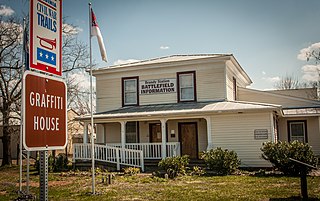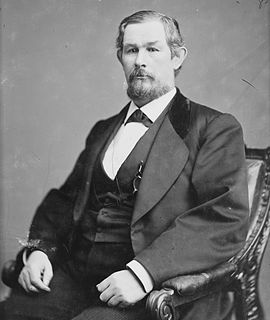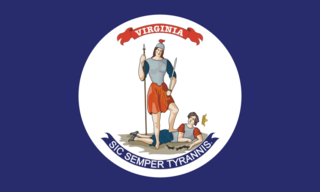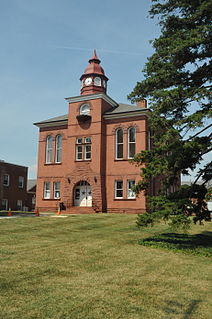
The Graffiti House, located at 19484 Brandy Road in the eastern end of the town of Brandy Station, Virginia, is believed by the Brandy Station Foundation to have been built in 1858. It is one of few dwellings in the village built before the American Civil War to survive intact to this day. The house is notable because of the Civil War era graffiti on many of the walls. The graffiti found includes names, drawings, names of units, and inscriptions left by soldiers.

Eppa Hunton II was a Virginia lawyer and soldier who rose to become a brigadier general in the Confederate Army during the American Civil War. After the war, he served as a Democrat in both the United States House of Representatives and then the United States Senate from Virginia.

Manassas National Battlefield Park is a unit of the National Park Service located in Prince William County, Virginia, north of Manassas that preserves the site of two major American Civil War battles: the First Battle of Bull Run, also called the First Battle of Manassas, and the Second Battle of Bull Run or Second Battle of Manassas. It was also where Confederate General Thomas J. Jackson acquired his nickname "Stonewall". The park was established in 1936 and listed on the National Register of Historic Places on October 15, 1966.

The 8th Virginia Infantry Regiment was a Confederate infantry regiment raised by Colonel Eppa Hunton in Leesburg, Virginia on May 8, 1861. The unit comprised six companies from Loudoun, two companies from Fauquier, one company from Fairfax and one company from Prince William. Initial regimental officers included: Lt. Colonel Charles B. Tebbs, Major Norborne Berkeley, John M. Orr - Quartermaster, Dr. Richard H. Edwards - Surgeon, Charles F. Linthicum - Chaplain. After Eppa Hunton's promotion to brigadier general in August 1863, in part based on his valor during the Battle of Gettysburg, particularly during Pickett's Charge, Norborne Berkeley was promoted to command the 8th Virginia, and his brother Edmund became the Lieut. Colonel, his brother William Berkeley, Major, and Charles Berkeley became the senior Captain of what then became known as the "Berkeley Regiment." Nonetheless, Norborne, William and Charles Berkeley were all in Union prisoner of war camps and their brother Edmund still recovering from his Gettysburg wound on August 9.

The 2nd Virginia Infantry Regiment was an infantry regiment raised in today's western Virginia and what became West Virginia during the American Civil War for service in the Confederate States Army. It would combine with the 4th, 5th, 27th, and 33rd Virginia infantry regiments and the Rockbridge Artillery Battery and fight as part of what became known as the Stonewall Brigade, mostly with the Army of Northern Virginia.

The 5th Virginia Infantry Regiment was an infantry regiment raised in Virginia for service in the Confederate States Army during the American Civil War. It fought in the Stonewall Brigade, mostly with the Army of Northern Virginia. The regiment was known as the "Fighting Fifth".

The 17th Virginia Infantry Regiment was an infantry regiment raised in Virginia for service in the Confederate States Army during the American Civil War. It fought mostly with the Army of Northern Virginia.

The 21st Virginia Infantry Regiment was an infantry regiment raised in Virginia for service in the Confederate States Army during the American Civil War. It fought mostly with the Army of Northern Virginia.

The 28th Virginia Infantry Regiment was an infantry regiment raised in Virginia for service in the Confederate States Army during the American Civil War. It fought mostly with the Army of Northern Virginia. The 28th Virginia completed its organization at Lynchburg, Virginia, in June, 1861. Its members were raised in the counties of Botetourt, Craig, Bedford, Campbell, and Roanoke.

Edgewood, also known as the John Boyd House, is a historic home located at Bunker Hill, Berkeley County, West Virginia. It was built in 1839 and is a two-story, five-bay, brick dwelling with a gable roof in the Greek Revival style. The entrance features a semi-elliptical transom and sidelights. The building has a two-story rear ell. The property includes a small log slave cabin.

James B. Terrill, often identified as James Barbour Terrill was a lawyer and an officer in the Confederate States Army.

Waveland is a historic plantation house and farm located near Marshall, Fauquier County, Virginia in the Carter's Run Rural Historic District. It was individually listed on the National Register of Historic Places in 2004, and the surrounding district listed in 2014.

Evergreen, one of the James River Plantations is a historic plantation house located just east of Hopewell, in Prince George County, Virginia. It was built about 1807 by planter, George Ruffin, and is a two-story, five-bay, Late Georgian / Federal style stuccoed brick dwelling. It sits on a high basement and has a hipped roof. The front facade features a one-story pedimented Doric order portico set on a brick podium. George Ruffin's son, ardent secessionist Edmund Ruffin, who is credited with firing one of the first shots at Fort Sumter at the start of the Civil War was born at Evergreen in 1794. The house was extensively renovated in the late-1930s, after prior use as a barn and stable.

Prince William County Courthouse is a historic courthouse located at 9248 Lee Avenue, Manassas, Prince William County, Virginia. Rehabilitated in 2000–2001, it currently houses some offices of the Prince William County clerk, and the historic courtroom upstairs can be rented for events.

Ben Lomond, also known as Ben Lomond Plantation, is a historic plantation house located at Bull Run, Prince William County, Virginia. It was built in 1837, and is a two-story, five bay, red sandstone dwelling with a gable roof. The house has a central-hall plan and one-story frame kitchen addition. One-story pedimented porches shelter the main (north) and rear (south) entries. Also on the property are the contributing frame two-story tenant's house, brick pumphouse, and a bunkhouse dated to the early 20th century; and a meat house, dairy, and slave quarters dated to the late-1830s.
Asa Rogers was an Virginia farmer, merchant, politician and Confederate officer from Middleburg. Loudoun County, Virginia.
The Manassas Peace Jubilee was a celebration that began 50 years after the start of the American Civil War, and was held in Manassas, Virginia, mostly between July 16 and July 21, 1911. This first major Civil War veterans' reunion marked fifty years after the First Battle of Bull Run, the first major conflict in what both sides originally thought would be a short war. Former Union officer turned Virginia lawyer and delegate George Carr Round and former Confederate officer and Lost Cause proponent Edmund Berkeley organized the event from Evergreen Manor House in nearby Haymarket, Virginia.

George Carr Round was a Union soldier who settled in Prince William County, Virginia after the American Civil War, where he became a lawyer, superintendent of public instruction in Manassas, Virginia and served a term in the Virginia General Assembly. Although Round donated the land for a more-accessible courthouse, organized the first public schools in the area and secured funding for the county's first public library, he became known nationally in his lifetime for organizing the Manassas Peace Jubilee in 1911, alongside fellow one-term delegate Edmund Berkeley and for contributing to the creation of Manassas National Battlefield Park decades after his death.
Norborne Berkeley was a northern Virginia planter who became an officer in the Confederate Army during the American Civil War, and afterward served in the Virginia Constitutional Convention of 1868 representing Loudoun County.

















